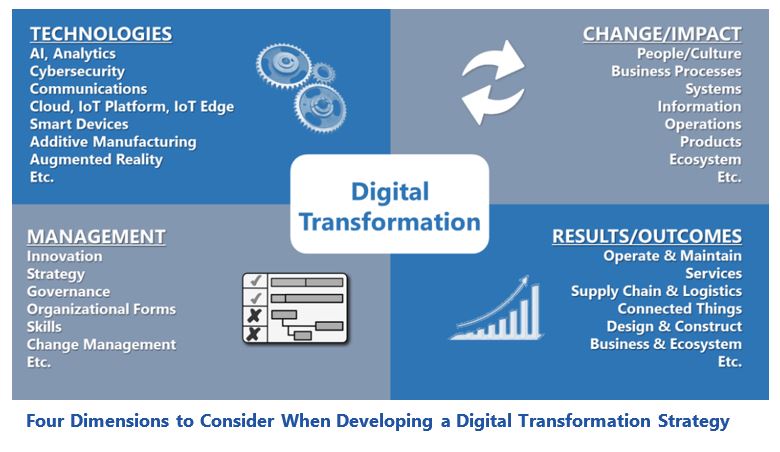

Digital transformation remains a top priority of most industrial companies. Driven by the prospect of innovative transformations powered by new technologies, industrial companies are engaging in digital transformation initiatives focused on new business processes, services, and competitive strategies.
To develop insight about how organizations are keeping up with the changes and transformations taking place throughout the industrial sector, the Digital Transformation Council and ARC Advisory Group conducted a survey of industrial companies.

The research was designed to give manufacturers and producers a feel for how their organization compares to others in progressing their digital transformation journeys. The research was conducted in the last quarter of 2019 and the first two months of 2020. Individuals from automotive, aerospace, chemical/petrochemical, electric power (generation, transmission, & distribution), electrical, food & beverage, high tech & electronics, industrial machines & equipment, life sciences, mining & metals, municipal/buildings, pulp & paper, refining, transportation, upstream oil & gas, and water & wastewater sectors participated in the survey. The majority of respondents were from North America, Western Europe, and Asia, but Eastern Europe, Latin America, and the Middle East and Africa were also represented. More than a third of the respondents worked for large companies (greater than $5 billion), and almost 30 percent worked for small (under $500 million) companies, with the rest falling somewhere in between. Similarly, over 40 percent of respondents worked for companies that own more than 50 plants/warehouses/facilities, about a quarter work for companies owning fewer than 10, and the rest fall somewhere in between. About 30 percent identified themselves as C-level executives or executive management and about 40 percent identified themselves as functional or supervisory managers. Respondents’ main focus in their organizations varied quite a bit, but was split among digital transformation/digital innovation, operations, engineering, IT, maintenance, business, and supply chain.
Key findings include:
Organizational issues often appear near the top of the list of queries benchmarking digital transformation at peer or other companies. What type of structure works? Who decides about new digital transformation initiatives? How much influence do others really have?
Industrial companies are using three main techniques to manage broad digital transformation initiatives in their organizations. It is quite common to see a formal executive-level role such as chief digital officer or digital transformation lead created to focus and lead the efforts. Recognizing that transformation crosses organizational boundaries, many companies have established cross-functional working groups for digital transformation. Other companies are content to leave digital transformation in the hands of line-of-business champions. ARC observes that leaders in digital transformation also establish metrics for digital success and ties them to both organizational and individual performance.
It is not surprising to learn that CEOs have some influence in authorizing and funding digital transformation initiatives, but the degree of involvement is a bit surprising. In this survey, CEOs topped the rankings, identified as the ‘Key Decider’ by over 35 percent of respondents, and either ‘Key Decider’ or ‘Great Influence’ by over 80 percent of respondents. This probably shouldn’t come as a surprise. Digital transformation presents both a significant opportunity and potentially a significant threat to industrial companies. For some time now, we have seen a great deal of C-level support for digital transformation initiatives. The CEO must balance quarterly market performance and strategic investments for the future.
Due to the broad, cross-functional nature of many digital transformation initiatives, many players throughout the organization have some influence when it comes to authorizing and funding digital transformation. Key influencers include CIOs; IT system managers; C-Level executives including COOs, CFOs, and CMOs; and plant managers and operations managers.
We asked whether digital transformation programs or initiatives were underway in six main business areas: business operations, supply chain and logistics, production operations, design and engineering, services and servitization, and (connected) products. Anecdotally, we knew that many industrial companies have digital transformation programs in more than one of these areas. The data bear this out. Among the respondents, production operations is the area most focused on, followed by supply chain and logistics, engineering and design, and business operations.
We also asked about three areas that could potentially benefit from digital transformation. Over 75 percent of respondents indicated that asset uptime and performance was an active program area. Sustainability has renewed interest as a corporate target and almost half of respondents see it as an area that could potentially benefit from a digital transformation. ARC has been encouraging clients to incorporate a strong customer focus in digital transformation programs because this is often at the root of successful transformations. There is room for improvement here as only about a quarter of respondents identify this as a digital transformation target area for their companies.
ARC Advisory Group clients can view the complete report at ARC Client Portal
If you would like to buy this report or obtain information about how to become a client, please Contact Us

